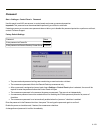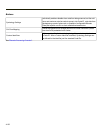
Bar Code Processing Overview
Bar code processing involves several steps. Some steps may be skipped during the processing depending on user selections
on the Scanner control panels. The steps are presented below in the order they are performed on the bar code data.
1. Scanned bar code is tested for a code ID and matching length (Min/Max). If it matches, it is processed per the rules in
place for that symbology. If the scan does not meet the criteria for that symbology, it is processed based on the settings
for All. If a code ID is not found, the bar code data is processed based on the settings for All.
2. If symbology is disabled, the scan is rejected.
3. Strip leading data bytes unconditionally.
4. Strip trailing data bytes unconditionally.
5. Parse for, and strip if found, Barcode Data strings.
6. Replace any control characters with string, as configured.
7. Add prefix string to output buffer.
8. If Code ID is not stripped, add saved code ID from above to output buffer.
9. Add processed bar code string from above to output buffer.
10. Add suffix string to output buffer.
11. Add a terminating NUL to the output buffer, in case the data is processed as a string.
12. If key output is enabled, start the process to output keys. If control characters are encountered:
l If Translate All is set, key is translated to CTRL + char, and output.
l If Translate All is not set, and key has a valid VK code, key is output.
l Otherwise, key is ignored (not output).
The bar code data is ready to be read by applications.
4-127


















